Strawberry Insect Pests
Strawberry Insect Pests
Leaf roller
Biology:The adult garden tortrix is a buff-brown moth that is about 1/4 inch (6 mm) long. Each of the forewings is marked with a dark brown diagonal stripe and a marginal spot producing a chevron pattern when at rest. A faint whitish line borders the anterior edge of the brown stripe. This character and the overall lighter color distinguish adult garden tortrix from orange tortrix. The slender caterpillars of the garden tortrix are nearly 1/2 inch (12 mm) long when mature. Caterpillars have light brown to green bodies and light brown heads. The head has a small, distinct dark brown spot on each side. Larvae and pupae overwinter in debris around the base of the plant.
Damage symptoms:- It ties one or more strawberry leaves together with white webbing to create shelters.
- Larvae can also create shelters by binding leaves or the sepals of the calyx to fruit and may feed from these sheltered areas on the surface or internal tissues of fruit.
White grub
Biology:- Egg - Eggs hatch in 3 to 4 weeks. A dull pearly white when first deposited, the oval to spherical egg turns dark just before hatching. It may be 1.5 to 3 mm in diameter. Small masses of 15 to 20 eggs occur in cells in the soil.
- Larva - Newly hatched grubs feed on plant roots throughout the summer and complete 1/3 of their development before fall. These grubs burrow below the frostline (to a depth of 1.5 meters) and hibernate. The young grub is creamy white and about 5 mm long. The grub is about 26 mm long, and the mature grub about 30 mm long. The C-shaped grub has a distinct brown head; a shiny, smooth body; and three pairs of legs just behind the head. Two rows of hairs on the underside of the last segment distinguish May beetle grubs from similar grubs.
- Pupa - The grubs become fully grown by late spring of the third year. At this time, they dig cells in the soil and pupate. Approximately the same size as the adult, the pupa may be creamy white, pale yellow, or dark brown. Pupae become adults by late summer but the beetles do not leave the ground.
- Adult - Known as May beetles, the shiny reddish-brown to black adults are 19 to 26 mm long. The adult attack strawberry during spring. New May beetles overwinter in their earthen cells and emerge the following spring to feed and mate.
White grubs complete one generation every 3 years.
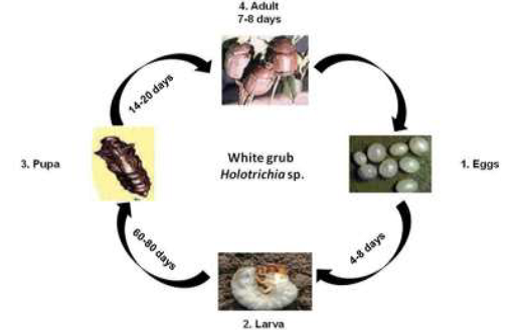
- Plants affected by this insect can show early signs of wilting, remain small, weak, and both yield and fruit quality is affected.
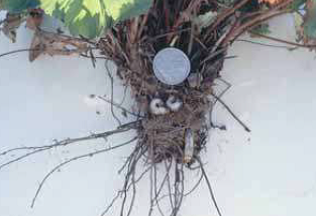
- Soil disclosure at the bottom, the larve is seen gathering on the roots.
- If large numbers of insects are present, plants may die
Thrips
Biology:- Egg: Eggs are laid in plant tissue, both in flower bottoms and in leaves.
- Larva: Subsequently, the larvae develop in stages. This development also occurs both in the leaves and in the flower bottoms of the plant.
- Pupa: In the pre-pupating stage the greater part of the thrips drops on the ground and looks for some dirt or creep under plastic to pupate. When the pupae have come out, the adult thrips will move to the plants again and after a number of days they will start laying eggs.
- Adult: Thrips wings are fringed with setae, small hairs. They are also known to be specially active in flying during hot and close weather. The best way to find thrips is by removing petals and the stamina of the flowers.
- Both nymphs and adult thrips can injure the plant by rasping the
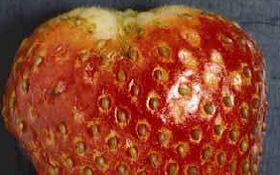 plant bud, flower, leaf tissues and then sucking the exuding sap.
plant bud, flower, leaf tissues and then sucking the exuding sap. - Thrips feeding on strawberry blossoms cause the stigmas and anthers to turn brown and wither prematurely, but not before fertilization has occurred.
- With high populations, the surface of the berry may become cracked and discolored.
- Fruit damage includes surface russeting around planting materials from late green to ripe fruit. The fruit can take on a seedy bronze-like appearance.
- Larvae and adult thrips will be sucking on the fruits.
- Brown scaly sucking patches round the planting materials planting materials planting materials.
Red spider mite
Biology:The two-spotted spider mite can live on strawberries, but also on numerous different crops. It is also present in different weeds, such as Black Nightshade, small stinging nettle and gallant soldier. The adult females overwinter in sheltered places in the crops. In spring they become active. Recognizing them, not the color is decisive but rather the two black spots on their body. Life stages comprises of egg, larvae, protonymph, deutonymph and adult. Life cycle will be completing in around 5-20 days depending on temperature.
- Egg: From mid April eggs are laid on the underside of the leaves. Female lays 100 eggs in around 10 days, round clear initially and turn whitish as it matures
- Nymph: The nymph vary in color, from yellow to light and dark green. Sometimes they are even orange in color.
- Adults: males are wedge shaped 0.33mm and females are oval 0.4-0.5 mm, single dark spot on either side of body and generally yellow or greenish in color.
Life Cycle:
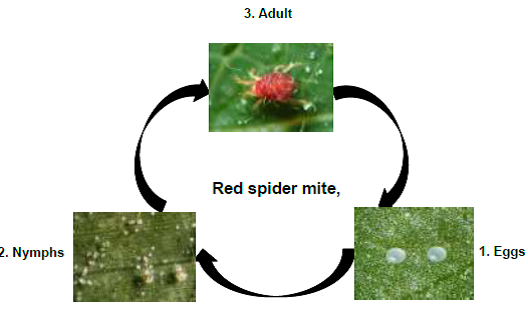
Damage symptoms:
- Spider mites rasp away leaf surfaces to feed on plant sap
- The first signs of damage are speckling and mottling on the surface of leaves.
- In heavy infestations, leaves turn purple, with white webbing between leaves.
- Plants that sustain infestations of greater than 75 mites per leaflet may become severely weakened and appear stunted, dry, and red in coloration.
- Severely damaged leaves die and drop
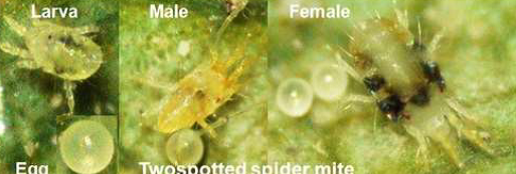
Root knot nematode
Biology:- Most species of plant parasitic nematodes have a relatively simple life cycle consisting of the egg, four larval stages and the adult male and female. They are microscopic in size.
- Development of the first stage larvae occurs within the egg where the first moult occurs. Second stage larvae hatch from eggs to find and infect plant roots or in some cases foliar tissues.
- Under suitable environmental conditions, the eggs hatch and new larvae emerge to complete the life cycle within 4 to 8 weeks depending on temperature.
- Nematode development is generally most rapid within an optimal soil temperature range of 70 to 80°F.
Life cycle:

Life stages are microscopic in size
Damage symptoms:
- Infected plants in patches in the orchard
- Formation of galls on host root system is the primary symptom
- Roots branch profusely starting from the gall tissue causing a ‘beard root’ symptom
- Infected roots become knobby and knotty
- In severely infected plants the root system is reduced and the rootlets are almost completely absent. The roots are seriously hampered in their function of uptake and transport of water and nutrients
- Plants wilt during the hot part of day, especially under dry conditions and are often stunted
- Seedlings infected in nursery do not normally survive transplanting and those surviving have reduced flowering and fruit production
- Nematode infection predisposes plants to fungal and bacterial root pathogens
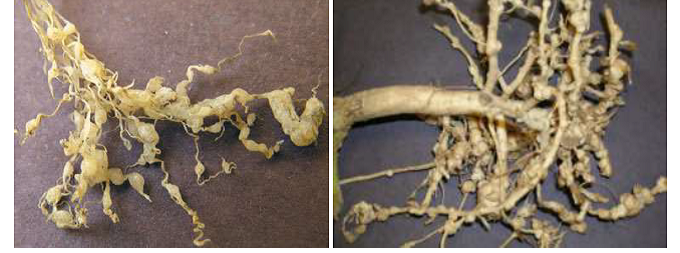
Survival and spread:
- Primary: Egg masses survive in infected plant debris and soil or collateral and other hosts like Solonaceous, Malvaceous and Leguminaceous plants act as sources of inoculum
- Secondary: Autonomous second stage juveniles that may also be water dispersed
- Loamy light soils
IPM for Strawberry
To know the IPM practices for Strawberry, click here.
Source: NIPHM; Directorate of Plant Protection, Quarantine & Storage
Last Modified : 4/2/2020
This topic covers the information related to Insec...
This topic covers information about Moth bean Inse...
Topic briefs the Management options for white grub...
This topic covers the information related to Insec...
